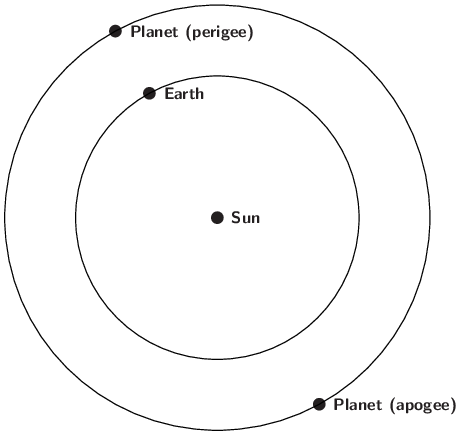134340 Pluto will reach opposition – the optimal time to observe it, when it will be visible for much of the night in the constellation Capricornus.
From South El Monte, it will be visible between 22:32 and 03:38. It will become accessible at around 22:32, when it rises to an altitude of 21° above your south-eastern horizon. It will reach its highest point in the sky at 01:05, 32° above your southern horizon. It will become inaccessible at around 03:38 when it sinks below 21° above your south-western horizon.
A close approach to the Earth

When a planet is at opposition, the solar system is aligned with that planet on the same side of the Sun as the Earth.
The term opposition refers to the moment when a planet passes opposite to the Sun in the sky. For those planets which orbit the Sun at a greater distance than the Earth – like 134340 Pluto – this geometry occurs as the two planets pass each other in their orbits and they make closest approach – termed its perigee.
At opposition / perigee, planets are visible for much of the night, reaching their highest point in the sky around midnight local time, just as the Sun, 180° away, dips to its lowest point below the horizon.
Because it passes closest to the Earth at this time, the planet also appears at its brightest around opposition.
In practice, the variation for 134340 Pluto is quite modest since it orbits much further out in the solar system than the Earth – at an average distance from the Sun of 39.34 times that of the Earth. Consequently, its distance and brightness does not vary much as it cycles between opposition and solar conjunction. The variation is much greater for Mars, since it lies much closer to the Earth.
Observing 134340 Pluto
At opposition, 134340 Pluto is visible for much of the night. Even when it is at its closest point to the Earth, however, 134340 Pluto is so distant from the Earth that it is not possible to distinguish it as more than a star-like point of light, even through a telescope.
A chart of the path of 134340 Pluto across the sky in 2026 can be found here, and a chart of its rising and setting times here.
At the moment of opposition, 134340 Pluto will lie at a distance of 34.55 AU, and reach a peak brightness of magnitude 14.9. At opposition, its celestial coordinates will be:
| Object | Right Ascension | Declination | Constellation | Magnitude | Angular Size |
| 134340 Pluto | 20h29m10s | 23°25'S | Capricornus | 14.9 | 0.0" |
The coordinates above are given in J2000.0.
Over the weeks following its opposition, 134340 Pluto will reach its highest point in the sky around four minutes earlier each night, gradually receding from the pre-dawn morning sky while remaining visible in the evening sky for a few months.
The sky on 26 Jul 2026
| The sky on 26 July 2026 | ||||||||||||||||||||||||||||||||||
|
96% 13 days old |
All times shown in PDT.
|
|||||||||||||||||||||||||||||||||
Source
The circumstances of this event were computed using the DE430 planetary ephemeris published by the Jet Propulsion Laboratory (JPL).
This event was automatically generated by searching the ephemeris for planetary alignments which are of interest to amateur astronomers, and the text above was generated based on an estimate of your location.
Related news
| 26 Jul 2026 | – 134340 Pluto at opposition |
| 28 Jul 2027 | – 134340 Pluto at opposition |
| 29 Jul 2028 | – 134340 Pluto at opposition |
| 31 Jul 2029 | – 134340 Pluto at opposition |
Image credit
© NASA/New Horizons


